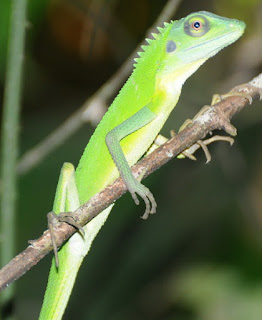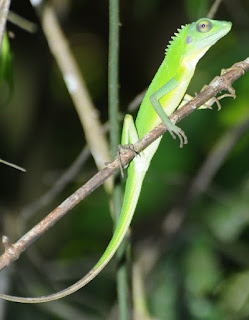With us this time were our enthusiastic young friend Eileen Chiang and her boyfriend Terence Ang. That's Eileen on the left, Bing on the right.
The vegetation of the Burmese pool area is not rainforest, but second growth interspersed with small farms. The area is a popular locally, featuring a trail to a waterfall and, as you might expect, a series of pools (though what is "Burmese" about them no one seems to recall).
Second-growth vegetation can have its epiphytic ornaments - this one is a fine Birds-nest Fern (Asplenium nidus).
As usual, seeing the birds was one thing but photographing them another - with the exception of this Asian Red-eyed Bulbul (Pycnonotus brunneus) in the middle of the road, too busy dealing with what appears to be a recalcitrant snail to pay any mind to us.
Once again, though the birds posed for our binoculars, it was the insects that posed best for my camera. This common and striking butterfly is a Yellow Glassy Tiger (Parantica aspasia aspasia), a relative of the Monarch (Danaus plexippus).
Here is another Danaiine, the Blue Glassy Tiger (Ideopsis vulgaris macrina).
And here are two views of a Chocolate Pansy (Junonia iphita horsfieldi).
Reptiles make pretty photogenic subjects, too. Witness this Green Crested Lizard (Bronchocela cristatella).
Green Crested Lizards possess the advantageous behaviour, for a photographer, of sitting much of the time in one spot and not moving unless they have to. Forest birds, by and large, don't do that.

Flying dragons are nice subjects too, but they are (a) well-camouflaged and a lot harder to spot; (b) considerably more skittish, and likely to circle around the trunk away from you or climb out of photographic reach; and (c) a lot tougher to identify to species (the Green Crested Lizard is a comparative cinch, because it is the only one of its genus in West Malaysia). I think this one is a Common Flying Dragon (Draco sumatranus), but it can be hard to tell.
Flying dragons don't actually fly, of course; they glide on membranes (or patagia) stretched between their exceptionally long (but foldable) ribs. They are the only living animals to glide in this manner, but we are now learning that this sort of gliding membrane has evolved over and over again in the past (see this excellent overview of both the living dragons and their fossil antecedents).
Though it is common to the point of ordinariness, I still enjoy seeing and photographing the delicate Orthetrum sabina (Libellulidae).
Another common libellulid dragonfly: Orthetrum testaceum.
>
This dragonfly may not seem to be much more remarkable than the last two, but it is, in fact, an astonishing creature: a Wandering Glider (Pantala flavescens), the most widespread dragonfly in the world. Its particularly broad hindwing is a clue to its flying skills: Wandering Gliders have colonized every continent but Antarctica, reached remote oceanic islands including Hawaii, and may even use passing hurricanes to help them cross the ocean on their regular migrations. Here is an article about their amazing peregrinations; it's quite a story.
























Great article.Thank you for sharing
ReplyDelete